typical values are specified at an ambient temperature of 25°C; minimum and maximum values are specified over an ambient temperature range of –40°C to +85°C; and ADC sampling rate = 2949.12 MSPS, DDC bypassed performance, 50% clock duty cycle, AVDD19 = 1.9 V, AVDD = DVDD = 1.15 V, –2-dBFS differential input, and 0-dB digital gain (unless otherwise noted)
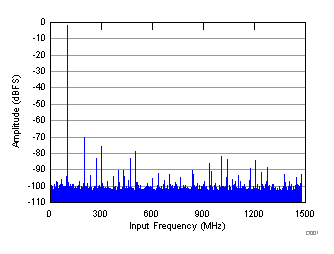
| SNR = 62.2 dBFS; SFDR = 68 dBc; HD2 = –68 dBc; HD3 = –73 dBc; non HD2, HD3 = 77 dBc; IL spur = 86 dBc; fIN = 100 MHz |
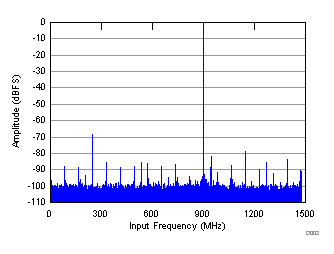
| SNR = 61.2 dBFS; SFDR = 66 dBc; HD2 = –77 dBc; HD3 = –66 dBc; non HD2, HD3 = 80 dBc; IL spur = 83 dBc; fIN = 900 MHz |
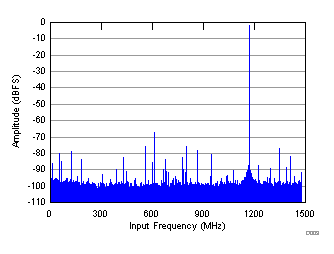
| SNR = 59.1 dBFS; SFDR = 65 dBc; HD2 = –65 dBc; HD3 = –73 dBc; non HD2, HD3 = 73 dBc; IL spur = 76 dBc; fIN = 1.7 GHz |
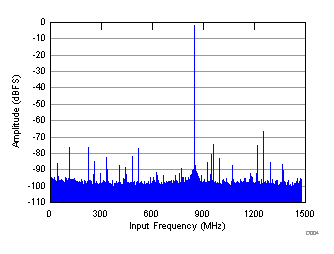
| SNR = 58.2 dBFS; SFDR = 64 dBc; HD2 = –64 dBc; HD3 = –85 dBc; non HD2, HD3 = 73 dBc; IL spur = 74 dBc; fIN = 2.1 GHz |
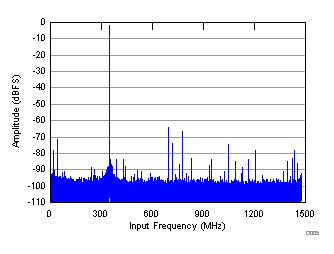
| SNR = 56.9 dBFS; SFDR = 62 dBc; HD2 = –62 dBc; HD3 = –72 dBc; non HD2, HD3 = 72 dBc; IL spur = 64 dBc; fIN = 2.6 GHz |
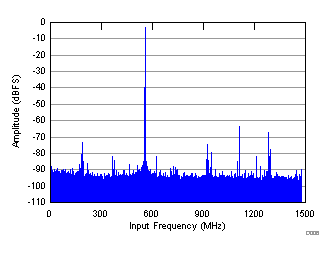
| SNR = 54.2 dBFS; SFDR = 60 dBc; HD2 = –60 dBc; HD3 = –64 dBc; non HD2, HD3 = 71 dBc; IL spur = 80 dBc; fIN = 3.5 GHz, AIN = –3 dBFS with 2-dB gain |
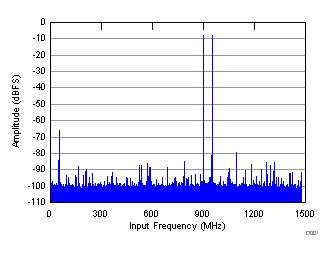
| fIN1 = 900 MHz, fIN2 = 950 MHz, AIN = –8 dBFS, IMD = 79 dBFS |
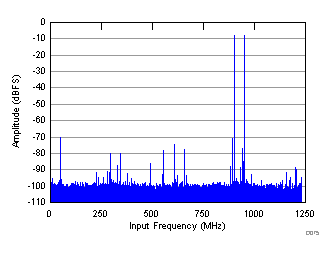
| fIN1 = 900 MHz, fIN2 = 950 MHz, AIN = –8 dBFS, IMD = 75 dBFS |
|
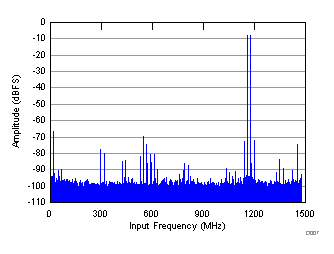
| fIN1 = 1.77 GHz, fIN2 = 1.79 GHz, AIN = –8 dBFS, IMD = 70 dBFS |
|
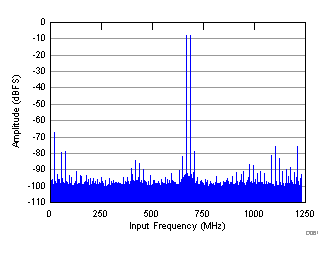
| fIN1 = 1.77 GHz, fIN2 = 1.79 GHz, AIN = –8 dBFS, IMD = 76 dBFS |
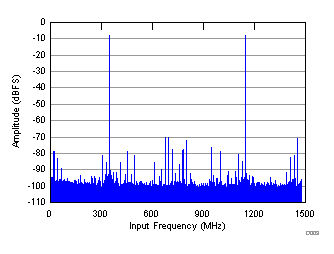
| fIN1 = 1.8 MHz, fIN2 = 2.6 GHz, AIN = –8 dBFS, IMD = 71 dBFS |
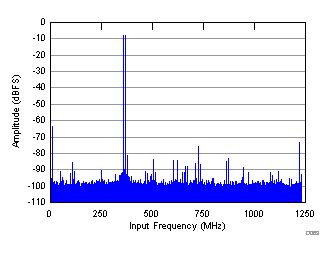
| fIN1 = 2.09 GHz, fIN2 = 2.1 GHz, AIN = –8 dBFS, IMD = 76 dBFS |
|
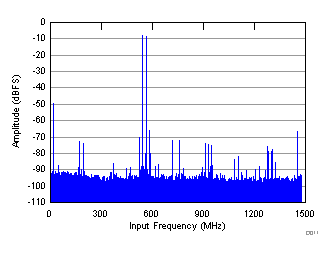
| fIN1 = 3.49 MHz, fIN2 = 3.51 GHz, IMD = 66 dBFS, AIN = –3 dBFS with 2-dB gain |
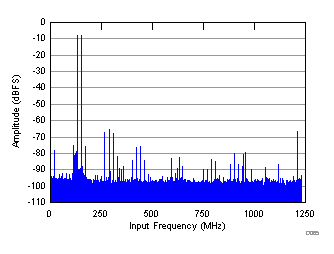
| fIN1 = 2.59 GHz, fIN2 = 2.6 GHz, AIN = –8 dBFS, IMD = 65 dBFS |
|
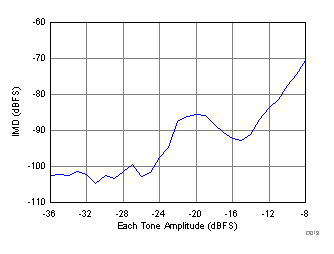
| fIN1 = 1.77 GHz, fIN2 = 1.79 GHz |
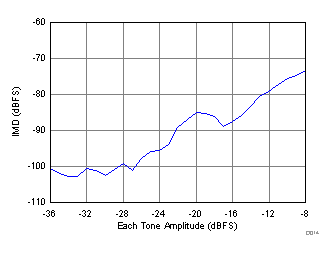
| fIN1 = 1.8 GHz, fIN2 = 2.6 GHz, AIN = –36 dBFS |
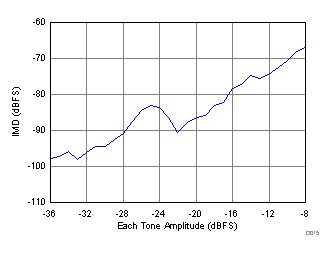
| fIN1 = 3.49 GHz, fIN2 = 3.51 GHz with 2-dB digital gain |
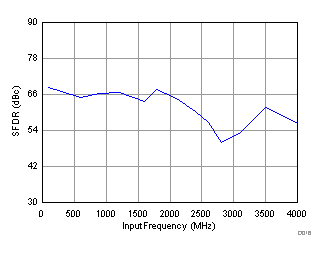
| AOUT = –2 dBFS with 0-dB gain for fIN less than 3 GHz, AOUT = –3 dBFS with 2-dB gain for fIN more than 3 GHz |
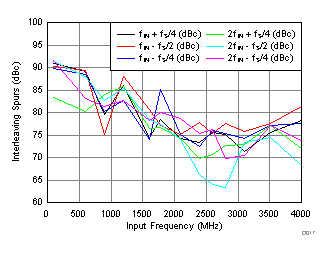
| AOUT = –2 dBFS with 0-dB gain for fIN less than 3 GHz, AOUT = –3 dBFS with 2-dB gain for fIN more than 3 GHz |
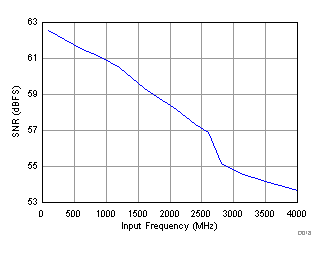
| AOUT = –2 dBFS with 0-dB gain for fIN less than 3 GHz, AOUT = –3 dBFS with 2-dB gain for fIN more than 3 GHz |
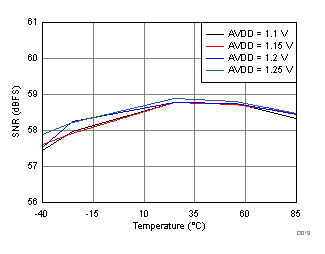
| fIN = 1.78 GHz, AIN = –2 dBFS |
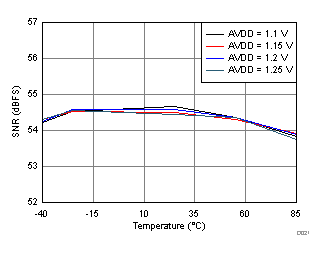
| fIN = 3.5 GHz, AIN = –3 dBFS with 2-dB digital gain |
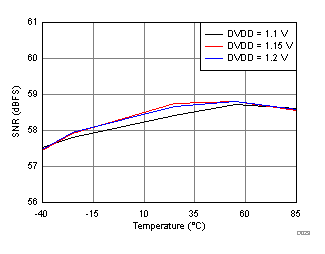
| fIN = 1.78 GHz, AIN = –2 dBFS |
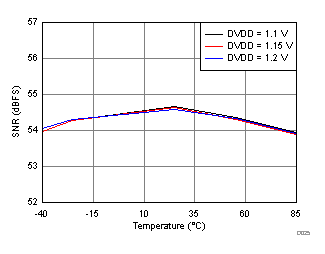
| fIN = 3.5 GHz, AIN = –3 dBFS with 2-dB digital gain |
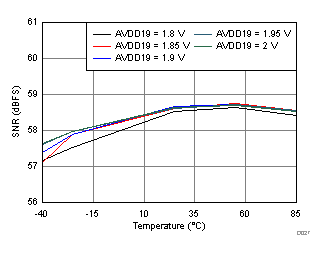
| fIN = 1.78 GHz, AIN = –2 dBFS |
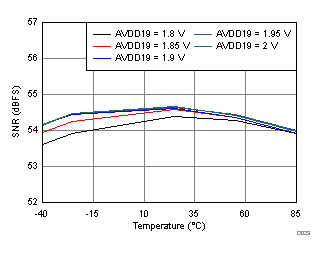
| fIN = 3.5 GHz, AIN = –3 dBFS with 2-dB digital gain |
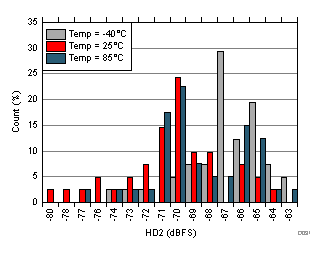 Figure 6-55 HD2 Histogram at AVDD19 = 1.8 V
Figure 6-55 HD2 Histogram at AVDD19 = 1.8 V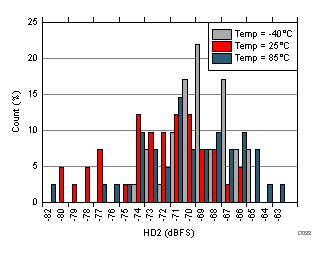 Figure 6-57 HD2 Histogram at AVDD19 = 2.0 V
Figure 6-57 HD2 Histogram at AVDD19 = 2.0 V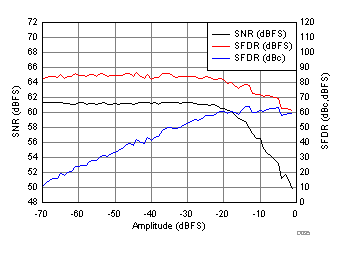
| fIN = 3.5 GHz, AIN = –3 dBFS with 2-dB digital gain |
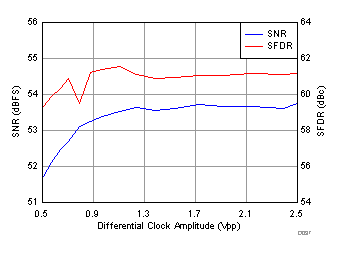
| fIN = 3.5 GHz, AIN = –3 dBFS |
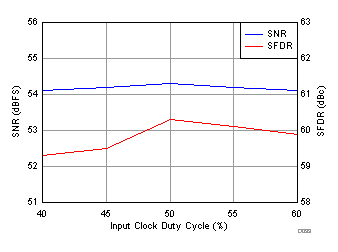
| fIN = 3.5 GHz, AIN = –3 dBFS with 2-dB digital gain |
|
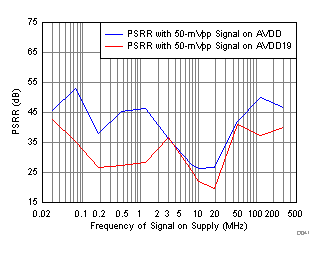 Figure 6-65 Power-Supply Rejection Ratio vs. Tone Frequency
Figure 6-65 Power-Supply Rejection Ratio vs. Tone Frequency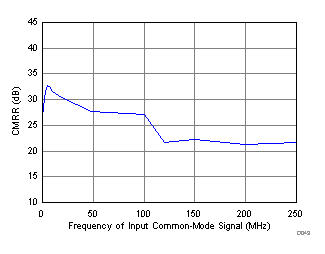
| fIN = 1.8 GHz, AOUT = –2 dBFS |
|
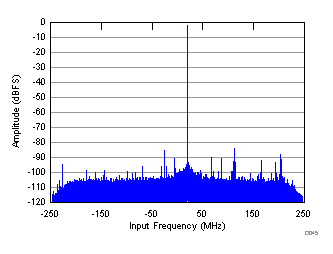
| fIN = 1.78 GHz, AIN = –2 dBFS, fS = 2949.12 MSPS, SNR = 61.6 dBFS, SFDR (includes IL) = 82 dBc |
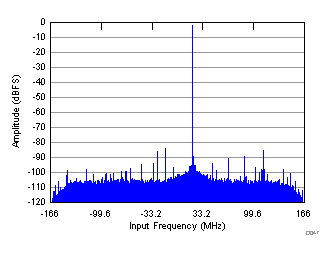
| fIN = 1.78 GHz, AIN = –2 dBFS, fS = 2949.12 MSPS, SNR = 63 dBFS, SFDR (includes IL) = 82 dBc |
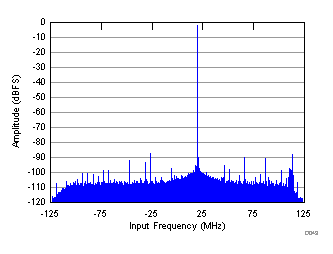
| fIN = 1.78 GHz, AIN = –2 dBFS, fS = 2949.12 MSPS, SNR = 63.7 dBFS, SFDR (includes IL) = 83 dBc |
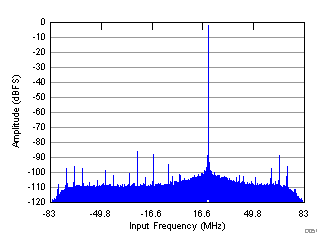
| fIN = 1.78 GHz, AIN = –2 dBFS, fS = 2949.12 MSPS, SNR = 64 dBFS, SFDR (includes IL) = 83 dBc |
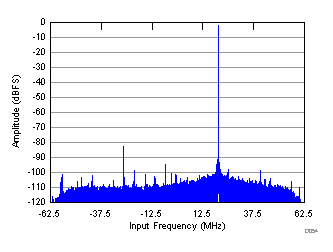
| fIN = 1.78 GHz, AIN = –2 dBFS, fS = 2949.12 MSPS, SNR = 64.4 dBFS, SFDR (includes IL) = 82 dBc |
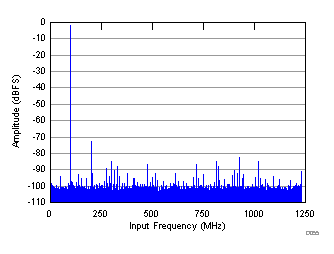
| SNR = 62.4 dBFS; SFDR = 71 dBc; HD2 = –71 dBc; HD3 = –83 dBc; non HD2, HD3 = 82 dBc; IL spur = 80 dBc; fIN = 100 MHz |
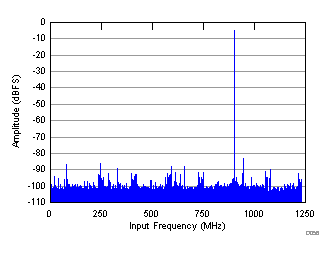
| SNR = 62.1 dBFS; SFDR = 76 dBc; HD2 = –76 dBc; HD3 = –83 dBc; non HD2, HD3 = 82 dBc; IL spur = 83 dBc; fIN = 900 MHz |
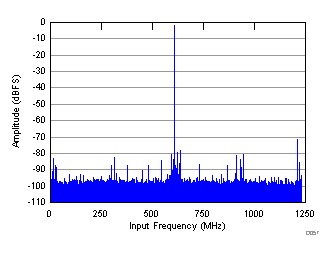
| SNR = 58 dBFS; SFDR = 69 dBc; HD2 = –69 dBc; HD3 = –75 dBc; non HD2, HD3 = 74 dBc; IL spur = 78 dBc; fIN = 1.85 GHz |
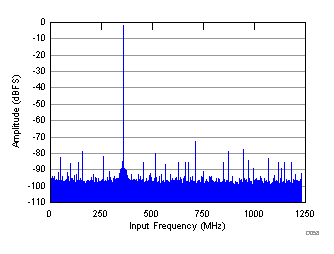
| SNR = 57.5 dBFS; SFDR = 70 dBc; HD2 = –70 dBc; HD3 = –81 dBc; non HD2, HD3 = 75 dBc; IL spur = 77 dBc; fIN = 2.1 GHz |
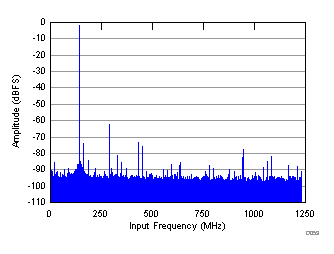
| SNR = 55.4 dBFS; SFDR = 60 dBc; HD2 = –60 dBc; HD3 = –67 dBc; non HD2, HD3 = 72 dBc; IL spur = 75 dBc; fIN = 2.6 GHz |
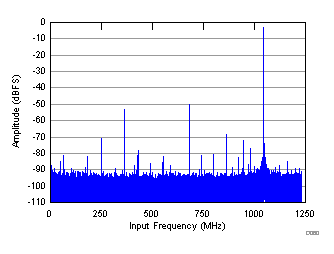
| SNR = 53.6 dBFS; SFDR = 47 dBc; HD2 = –50 dBc; HD3 = –47 dBc; non HD2, HD3 = 70 dBc; IL spur = 67 dBc; fIN = 3.5 GHz, AIN = –3 dBFS with 2-dB gain |
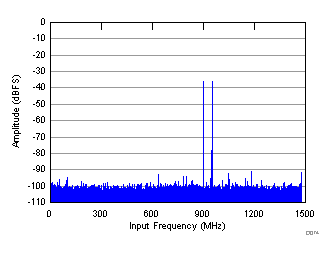
| fIN1 = 900 MHz, fIN2 = 950 MHz, AIN = –36 dBFS, IMD = 97 dBFS |
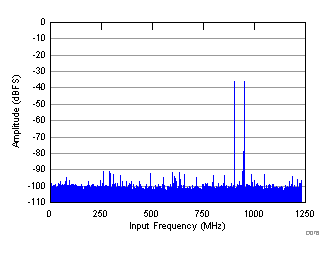
| fIN1 = 900 MHz, fIN2 = 950 MHz, AIN = –36 dBFS, IMD = 92 dBFS |
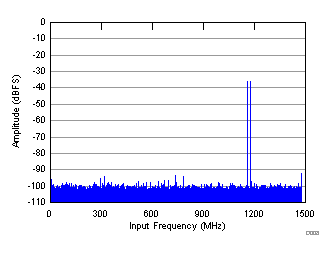
| fIN1 = 1.77 GHz, fIN2 = 1.790 GHz, AIN = –36 dBFS, IMD = 97 dBFS |
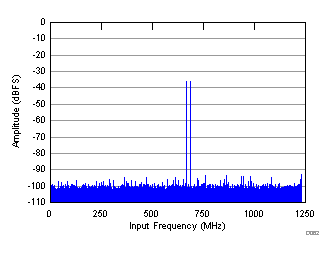
| fIN1 = 1.77 GHz, fIN2 = 1.790 GHz, AIN = –36 dBFS, IMD = 96 dBFS |
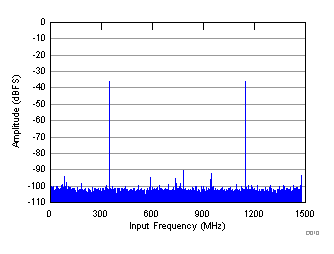
| fIN1 = 1.8 GHz, fIN2 = 2.6 GHz, AIN = –36 dBFS, IMD = 94 dBFS |
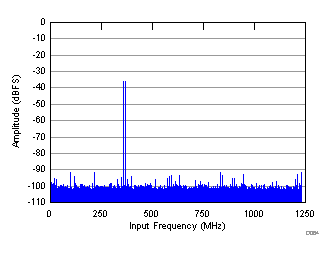
| fIN1 = 2.09 MHz, fIN2 = 2.1 GHz, AIN = –36 dBFS, IMD = 94 dBFS |
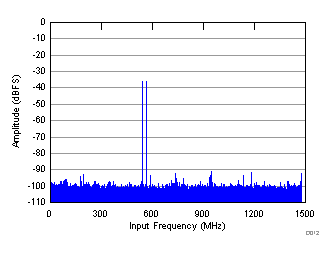
| fIN1 = 3.49 GHz, fIN2 = 3.51 GHz, IMD = 92 dBFS, AIN = –3 dBFS with 2-dB gain |
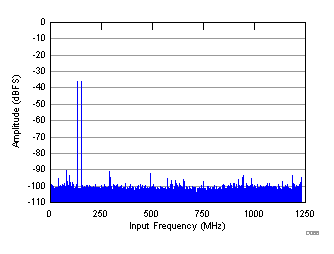
| fIN1 = 2.59 GHz, fIN2 = 2.6 GHz, AIN = –36 dBFS, IMD = 92 dBFS |
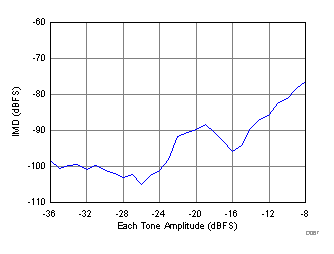
| fIN1 = 1.77 GHz, fIN2 = 1.79 GHz |
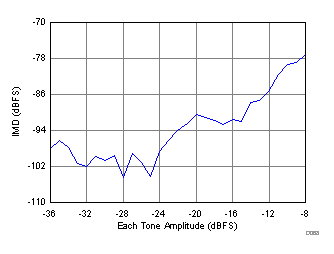
| fIN1 = 2.09 GHz, fIN2 = 2.1 GHz |
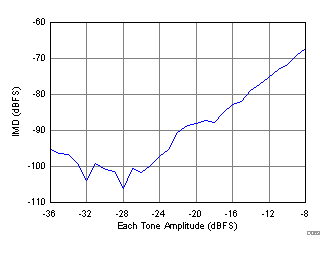
| fIN1 = 2.59GHz, fIN2 = 2.6 GHz |
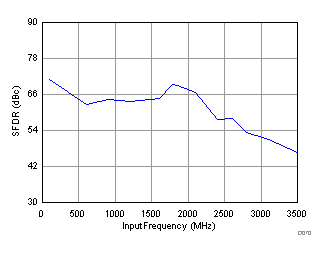
| AOUT = –2 dBFS with 0-dB gain for fIN less than 3 GHz, AOUT = –3 dBFS with 2-dB gain for fIN more than 3 GHz |
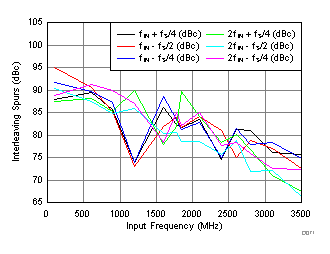
| AOUT = –2 dBFS with 0-dB gain for fIN less than 3 GHz, AOUT = –3 dBFS with 2-dB gain for fIN more than 3 GHz |
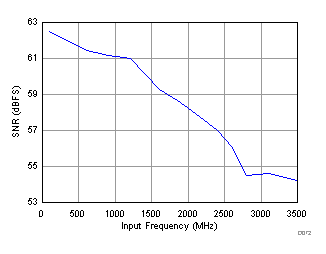
| AOUT = –2 dBFS with 0-dB gain for fIN less than 3 GHz, AOUT = –3 dBFS with 2-dB gain for fIN more than 3 GHz |
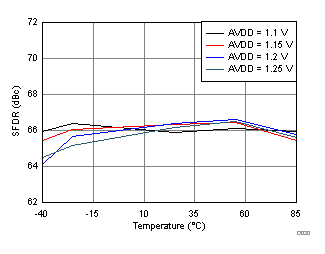
| fIN = 1.78 GHz, AIN = –2 dBFS |
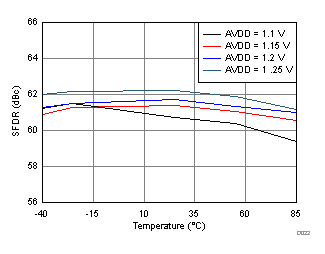
| fIN = 3.5GHz, AIN = –3 dBFS with 2-dB digital gain |
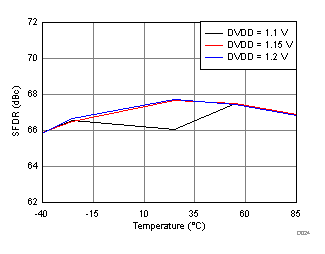
| fIN = 1.78 GHz, AIN = –2 dBFS |
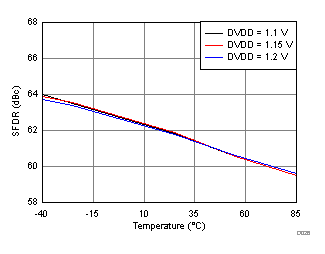
| fIN = 3.5 GHz, AIN = –3 dBFS with 2-dB digital gain |
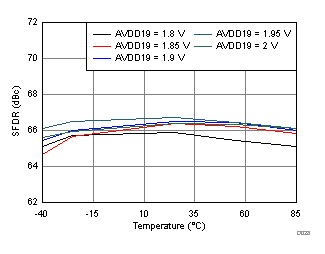
| fIN = 1.78 GHz, AIN = –2 dBFS |
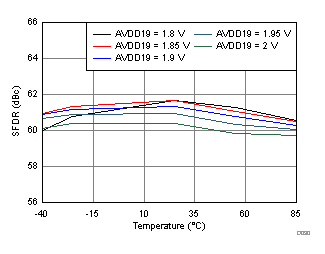
| fIN = 3.5 GHz, AIN = –3 dBFS with 2-dB digital gain |
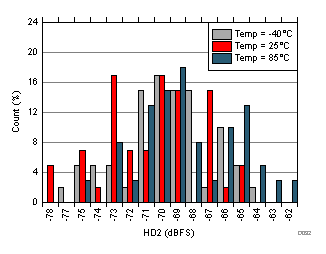 Figure 6-56 HD2 Histogram at AVDD19 = 1.9 V
Figure 6-56 HD2 Histogram at AVDD19 = 1.9 V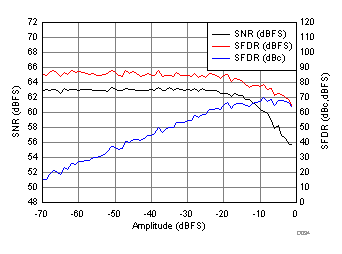
| fIN = 1.78 GHz, AIN = –2 dBFS |
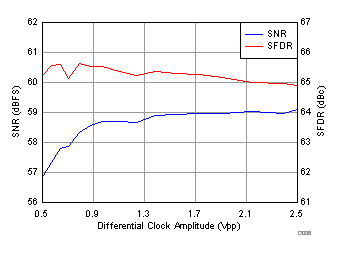
| fIN = 1.78 GHz, AIN = –2 dBFS |
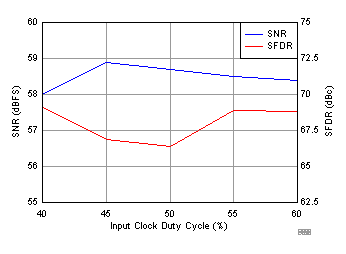
| fIN = 1.78 GHz, AIN = –2 dBFS |
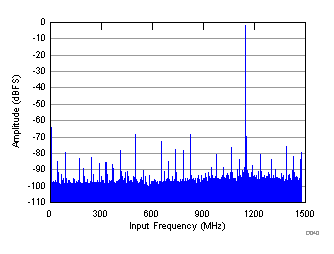
| fIN = 3.5 GHz, AIN = –3 dBFS, PSRR = 37 dB, fPSRR = 3 MHz, APSRR = 50 mVPP, AVDD = 1.9 V |
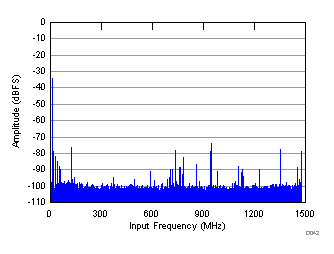
| CMRR
= 32 dB, fCMRR = 32 dB, APSRR = 50
mVPP |
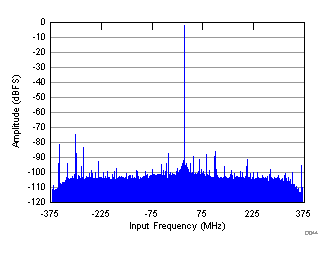
| fIN = 1.78 GHz, AIN = –2 dBFS, fS = 2949.12 MSPS, SNR = 60.6 dBFS, SFDR (includes IL) = 75 dBc |
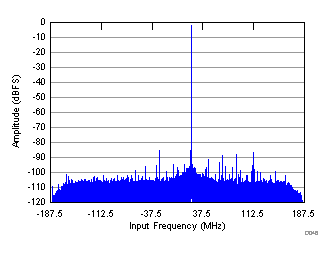
| fIN = 1.78 GHz, AIN = –2 dBFS, fS = 2949.12 MSPS, SNR = 62.6 dBFS, SFDR (includes IL) = 86 dBc |
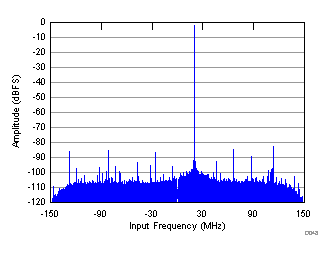
| fIN = 1.78 GHz, AIN = –2 dBFS, fS = 2949.12 MSPS, SNR = 63.3 dBFS, SFDR (includes IL) = 81 dBc |
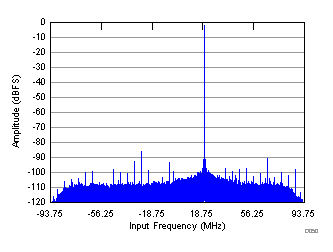
| fIN = 1.78 GHz, AIN = –2 dBFS, fS = 2949.12 MSPS, SNR = 63.9 dBFS, SFDR (includes IL) = 83 dBc |
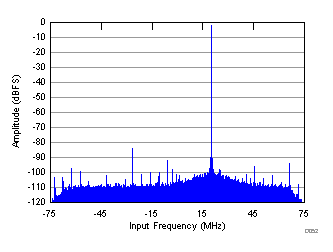
| fIN = 1.78 GHz, AIN = –2 dBFS, fS = 2949.12 MSPS, SNR = 64.4 dBFS, SFDR (includes IL) = 84 dBc |
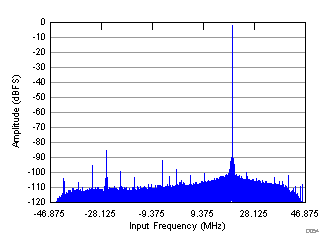
| fIN = 1.78 GHz, AIN = –2 dBFS, fS = 2949.12 MSPS, SNR = 64.5 dBFS, SFDR (includes IL) = 79 dBc |































 Figure 6-65 Power-Supply Rejection Ratio vs. Tone Frequency
Figure 6-65 Power-Supply Rejection Ratio vs. Tone Frequency










































